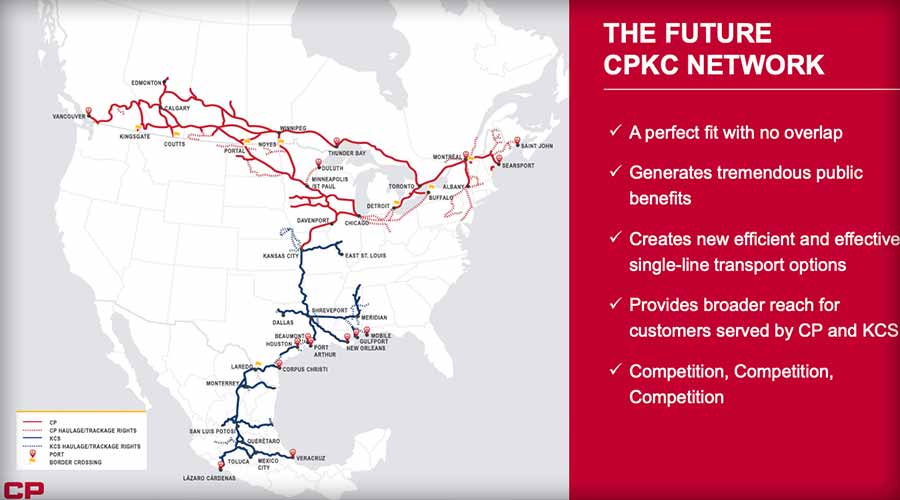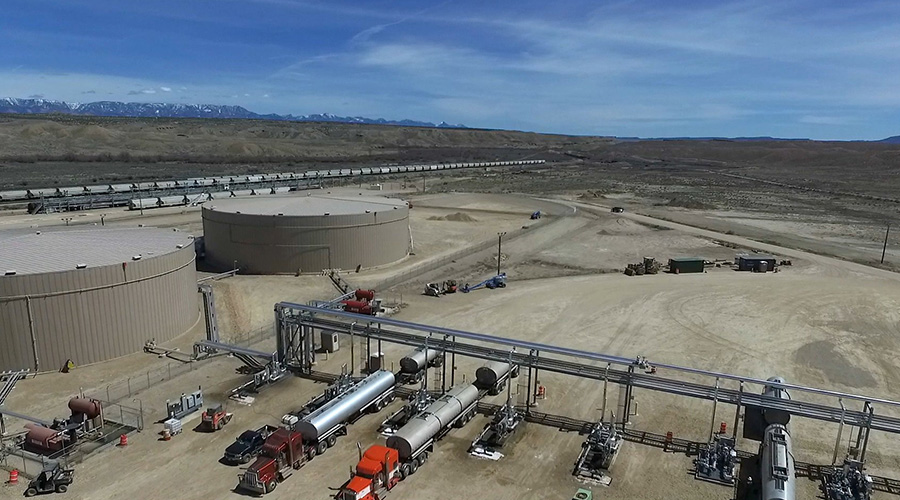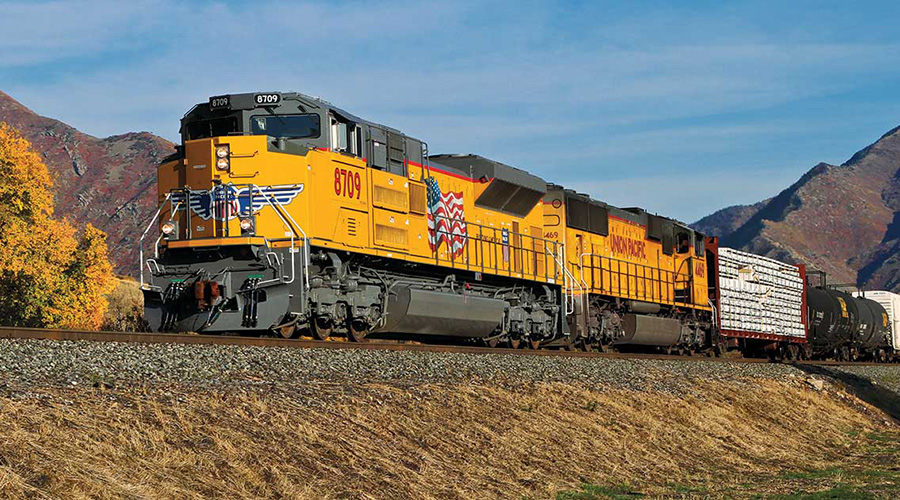Time for rebuttal: CP, KCS restate their merger case to STB
10/14/2022
By Julie Sneider, Senior Associate Editor
Editor’s note: This is the third RailPrime story about the Surface Transportation Board’s public hearing held over seven days in late September and early October on the proposed merger between Canadian Pacific and Kansas City Southern.
Last week, the Surface Transportation Board (STB) concluded what ended up being a seven-day public hearing on the proposed merger between Canadian Pacific and Kansas City Southern. The final two days consisted of CP and KCS executives and their attorney reiterating their rationale for why combining their operations into a single railroad that will stretch from Canada through the United States and into Mexico will benefit the public interest and the North American rail network. They also responded to comments and concerns from speakers at the hearings, which included representatives of communities, ports, other Class Is, labor unions, environmental groups, shippers, rail customers, and local and federal governments.
The next step in the process is for CP and KCS to file their final briefs with the STB. The board’s Office of Environmental Analysis has yet to issue a final environmental impact statement; once that’s available, a public comment period will follow. The STB has until February 2023 to approve or deny the merger application.
As part of their wrap-up presentation (given Oct. 6-7), CP and KCS filed their “Rebuttal Presentation” with the STB; that document can be viewed by clicking on this link.
 CP and KCS executives on Oct. 6-7 gave their rebuttal presentation to the Surface Transportation Board following a public hearing on the Class Is’ proposed merger. Shown at center is CP President and CEO Keith Creel; second from the right is KCS President and CEO Patrick Ottensmeyer. Surface Transportation Board
CP and KCS executives on Oct. 6-7 gave their rebuttal presentation to the Surface Transportation Board following a public hearing on the Class Is’ proposed merger. Shown at center is CP President and CEO Keith Creel; second from the right is KCS President and CEO Patrick Ottensmeyer. Surface Transportation Board In their rebuttal, the CP and KCS team reiterated their belief that the merger will: lead to a more competitive North American transportation system; support investment in U.S. rail infrastructure; increase rail industry employment; remove trucks off U.S. highways as more customers ship their goods by rail; and support U.S.-Mexico-Canada trade and economic development.
“Having sat through the testimony of the past week, I am even more excited about the opportunities created by this transaction,” CP President and CEO Keith Creel told the STB. “I am more confident that the arguments made against [the merger] have no merit.”
In their final presentation, the CP-KCS team highlighted topics raised during the hearing, including the benefits and operational impacts of the combined railroads, and the considerations that went into their operational planning and service assurance commitments, including in specific rail corridors around Chicago, from Texas to the Twin Cities, and the Meridian Speedway; various rail yards; and the Wylie Intermodal Terminal. They also reported on rail performance over trackage owned by third parties, including Union Pacific Railroad and Chicago’s Metra.
Responses to Chicago-area concerns
For example, CP and KC officials promised to report monthly their train counts, lengths and transit times during the transition period when the merged railroad would be operating under the STB’s oversight. In Chicago, the combined railroads also would report monthly on all delays to Metra trains on the Milwaukee District-West and Milwaukee District-North lines that related to CP’s freight operations.
CP and KCS officials also spent considerable time responding to eight Chicago suburban communities’ and Metra’s claims about how the merger would impact them. The Coalition to Stop CPKC opposes the merger for what its members say would lead to increased safety hazards, environmental degradation, noise, Metra train delays and truck and vehicle traffic due to blocked crossings. And Metra Executive Director and CEO Jim Derwinski testified that with the amount of existing freight and passenger traffic that moves through Chicago, there is little room on the existing infrastructure for more freight trains generated by a merged CPKC.
In their rebuttal, CP executives noted the company already has non-merger-related capital plans for the region, including an expansion at the Bensenville rail yard near Chicago. CP also has contributed to the Chicago Region Environmental and Transportation Efficiency (CREATE) project, a public-private partnership that’s spending billions of dollars on maintenance-of-way and infrastructure projects to improve the efficiency of freight-rail traffic through Chicago. Significant post-merger investments also are planned, including projects that would extend or build new sidings in multiple locations, CP officials said.
Moreover, the concern that CPKC would route a post-merger growth in freight traffic through an already heavily congested Chicago is a “red herring,” according to David Meyer, who served as counsel to CP and KCS during the hearing.
 “I’ve known from the beginning this is a perfect merger.”— Keith Creel, Canadian Pacific cpr.ca
“I’ve known from the beginning this is a perfect merger.”— Keith Creel, Canadian Pacific cpr.caThe concern raised by the coalition and Metra start with CP’s Marquette Subdivision and a rail route between St. Paul, Minnesota, and Kansas City, Missouri. That route moves from St. Paul south to River Junction, onto the Marquette Subdivision and then to Sabula Junction, Iowa, and from there to Kansas City. At about 161 miles, it’s the shortest and most direct route for a train to move freight from St. Paul to Kansas City.
But Metra and Coalition to Stop CPKC representatives have said they believe the Marquette Subdivision lacks the capacity to handle additional freight trains between St. Paul and Kansas City, which would prompt CPKC to route potential increases in freight traffic away from the Marquette and through Milwaukee/Chicago using rail lines CP shares with Metra.
That route would be 413 miles long, however.
“CP would never route a freight train from St. Paul to Kansas City via Milwaukee/Chicago except in the event of an unlikely emergency,” said Raymond Elphick, CP’s assistant vice president of service and product design, to the board members. “That would be an extra 250 miles and wouldn’t make sense operationally or commercially.”
Additionally, the concern that the Marquette Subdivision can’t be expanded is “simply wrong,” Elphick said. Besides capacity expansion projects already in the works, others can be deployed if growth exceeds CP’s expectations, he said.
As for Metra, CP has made several commitments to the Chicago commuter railroad beyond not forcing St. Paul-Kansas City-bound freight to move on shared lines through Chicago. Those commitments include working collaboratively with Metra to address various other concerns related to on-time performance and CP’s train dispatch authority on Metra’s lines. However, CP remains opposed to granting Metra’s condition that CP turn over that dispatch authority to Metra.
CP: A ‘perfect merger’
Later in the hearing, CP and KCS executives responded to other speakers’ suggestions and concerns over what the merger would mean for their railroads, routes owned by other Class Is and shared with CPKC or the overall impact the merger would have on service to rail shippers and customers. To view the last two days of the hearing when those issues were addressed, click here for Hearing Day 6 and here for Hearing Day 7.
By the end of the seven days, CP’s Creel attributed the other Class Is’ objections to the merger as concerns about the “hard competition” a combined CPKC will bring to the rail marketplace. He thanked the board members for their “care, concern and attention” given to CP-KCS application.
“I’ve known from the beginning this is a perfect merger — it’s pro-competitive, pro-growth, pro-job growth and pro-environment,” Creel said.


